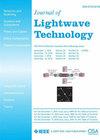Probabilistic Shaping for Nonlinearity Tolerance
IF 4.1
1区 工程技术
Q2 ENGINEERING, ELECTRICAL & ELECTRONIC
引用次数: 0
Abstract
Optimizing the input probability distribution of a discrete-time channel is a standard step in the information-theoretic analysis of digital communication systems. Nevertheless, many practical communication systems use transmission based on uniformly and independently distributed symbols drawn from regular constellation sets. The introduction of the probabilistic amplitude shaping architecture has helped to renew interest in using optimized probability distributions, i.e., probabilistic shaping. Traditionally, probabilistic shaping has been employed to reduce the transmit power required for a given information rate over additive noise channels. While this translates into substantive performance gains for optical fiber communication systems, the interaction of shaping and fiber nonlinearity has posed intriguing questions. At first glance, probabilistic shaping seems to exacerbate nonlinear interference noise (NLIN) due to larger higher-order standardized moments. Therefore, the optimization of shaping distributions must differ from those used for linear channels. Secondly, finite-length effects related to the memory of the nonlinear fiber channel have been observed. This suggests that not only the marginal input-symbol distribution should be looked at. In this paper, we provide a tutorial-style discussion of probabilistic shaping for optical fiber communication. Since the distinguishing property of the channel is the signal-dependent NLIN, we speak of probabilistic shaping for nonlinearity tolerance. Our analysis builds on the first-order time-domain perturbation approximation of the nonlinear fiber channel and revisits the notion of linear and nonlinear shaping gain. We largely focus on probabilistic amplitude shaping with popular types of shaping methods, and examine a linear filter model to explain several phenomena associated with probabilistic shaping for fiber nonlinearity, including the interaction between carrier phase recovery and fiber nonlinearity. The concept of shaping via sequence selection is given special consideration, as it inherently optimizes a multi-variate distribution for shaped constellations. We explore how using sign bits for sequence selection offers benefits beyond amplitude shaping, and we introduce a sign-dependent selection metric based on the perturbation model.求助全文
约1分钟内获得全文
求助全文
来源期刊

Journal of Lightwave Technology
工程技术-工程:电子与电气
CiteScore
9.40
自引率
14.90%
发文量
936
审稿时长
3.9 months
期刊介绍:
The Journal of Lightwave Technology is comprised of original contributions, both regular papers and letters, covering work in all aspects of optical guided-wave science, technology, and engineering. Manuscripts are solicited which report original theoretical and/or experimental results which advance the technological base of guided-wave technology. Tutorial and review papers are by invitation only. Topics of interest include the following: fiber and cable technologies, active and passive guided-wave componentry (light sources, detectors, repeaters, switches, fiber sensors, etc.); integrated optics and optoelectronics; and systems, subsystems, new applications and unique field trials. System oriented manuscripts should be concerned with systems which perform a function not previously available, out-perform previously established systems, or represent enhancements in the state of the art in general.
 求助内容:
求助内容: 应助结果提醒方式:
应助结果提醒方式:


